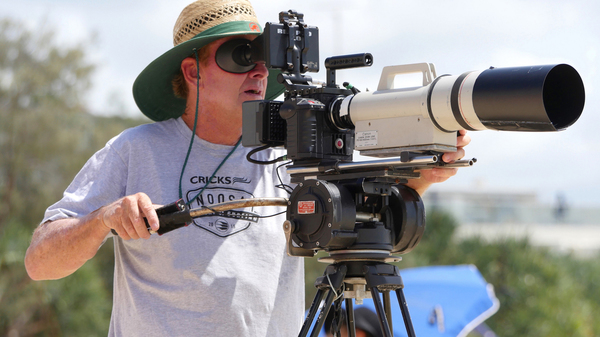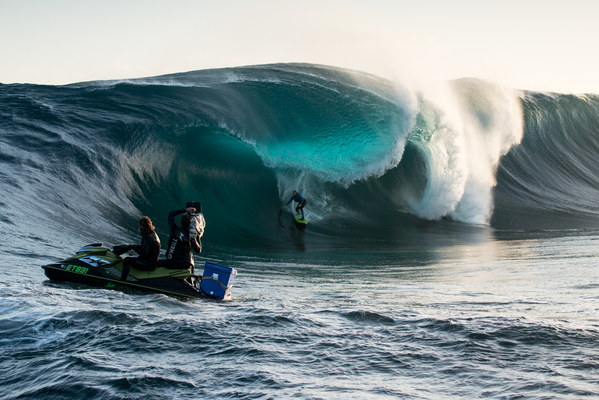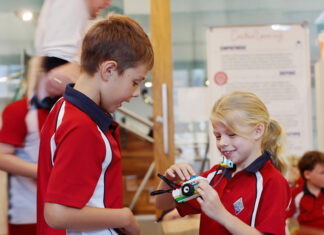By Phil Jarratt
I’m a bit too young (no laughing please) to have caught the fabulous tent show surf movies of the late 1950s and early ’60s, when often the film-maker himself – Bud Browne, John Severson, Val Valentine, and later Bob Evans – would sit next to the screen with a tinny mic in his hand and narrate his own movie.
By the time I saw my first surf movie – Slippery When Wet, as I recall – they had graduated to actual cinemas, where vast hordes of us gremmies would gather to hoot and holler, stamp our feet and roll Jaffas down the aisles. The climactic scene, where we would collectively lose it, screaming, kicking the chair in front and smashing our fists on the arm rests, was always the big wave wipeout sequence, where Greg Noll, Jose Angel, Peter Cole and friends would freefall down the face at Waimea and surely die … you would think.
It’s more than half a century since those halcyon days, and surfing and surf movies have changed so much a time traveller would not recognise them. Except for one thing. The most exciting sequence is still the massive waves and wipeouts finale. The names and locations have changed, of course, and modern cinematography takes you inside the experience in a way that an old Bolex on top of a hill never could, but the thrill is just the same. Oh my god, he’s paddling, he’s up, he’s never going to make it and look at this monster jacking up in front of him! Goose bumps, or chicken skin, as our friends over there in Trumpland say.
Since the advent of tow-in, flotation equipment and high-tech speed guns, the act of riding huge waves has become far more technical – enabling today’s chargers to ride waves more than twice as large as those ridden in the ’60s. And so too has the technology of big wave cinematography, the art of shooting monsters. Sophisticated cameras like the Red Epic and fast-moving inflatables have enabled today’s big wave filmers to get closer to the action than ever before, to slow it down so that we can understand the forces of nature in play, and to present it from a variety of angles so that the surfer’s engagement (not to mention proximity to death) can be comprehended.
Big wave cinematography is a thrilling and often dangerous pursuit, and I am delighted to be hosting a luncheon at the Laguna Real Estate Noosa Festival of Surfing featuring two of the biggest names in the genre. Appropriately titled Shooting Monsters, and interspersed with several courses of great food at El Capitano on Hastings Street, this video and talk show will highlight the work of Australia’s Tim Bonython and America’s Greg Huglin. Both veterans in the genre, they have very different and very entertaining perspectives on the big wave experience, having shot on the biggest days ever ridden at places like Peahi (Jaws), Shark Park, Mavericks, Todos Santos, Shipstern’s Bluff, The Right, Teahupoo and Nazare.
Tim Bonython started filming big waves on his first trip to Hawaii in 1978, honing his craft to such a degree over the next 20 years that his 1998 film, Biggest Wednesday, which microscopically presents a next-level day at Jaws, is still regarded as a true classic of big wave film, and has sold more than 130,000 units in VHS and DVD. Following the success of Biggest Wednesday, Tim and his wife Sandrine set up the touring Australian Surf Film Festival, annually reviving the tradition of summer surf movies in small towns up and down the coast.
Now in his fifties, Tim has remained active behind the lens, winning many awards for his commercial work, continually chasing swells around the world and shooting landmark work at new locations such as Nazare, Portugal. Frequently putting himself in harm’s way to capture the shot, Tim was almost killed last year when a huge wave flipped his boat in Victoria.
Californian Greg Huglin, who made his first surf film as a college student in 1971, shared an Academy Award for cinematography for his work on the 2010 eco-documentary The Cove. Between his start in San Francisco and his recent work while resident in Noosa, Greg has worked with the giants of the film business, mentored young wannabe film-makers like Jack Johnson (who did better with music) and has shot more than 200 feature films, shorts and commercials, mostly ocean-related.
Despite his stellar commercial career, Greg’s lifelong passion has been shooting monsters, and, like Tim, he has continued to chase huge swells around the world, filming extraordinary footage in California, Mexico and Hawaii.
Tim and Greg will present snippets of their life’s work in big waves, and tell the inside stories of how they got the shot, whether they got pitched over the falls, and how the hell today’s big wave chargers can pull into those black pits of death.
It’s going to be an exciting, enjoyable afternoon on Monday 6 March, and I can’t wait.
Tickets are available at www.noosafestivalofsurfing.com/shooting-monsters, but there are limited numbers, so hurry while stocks last.








